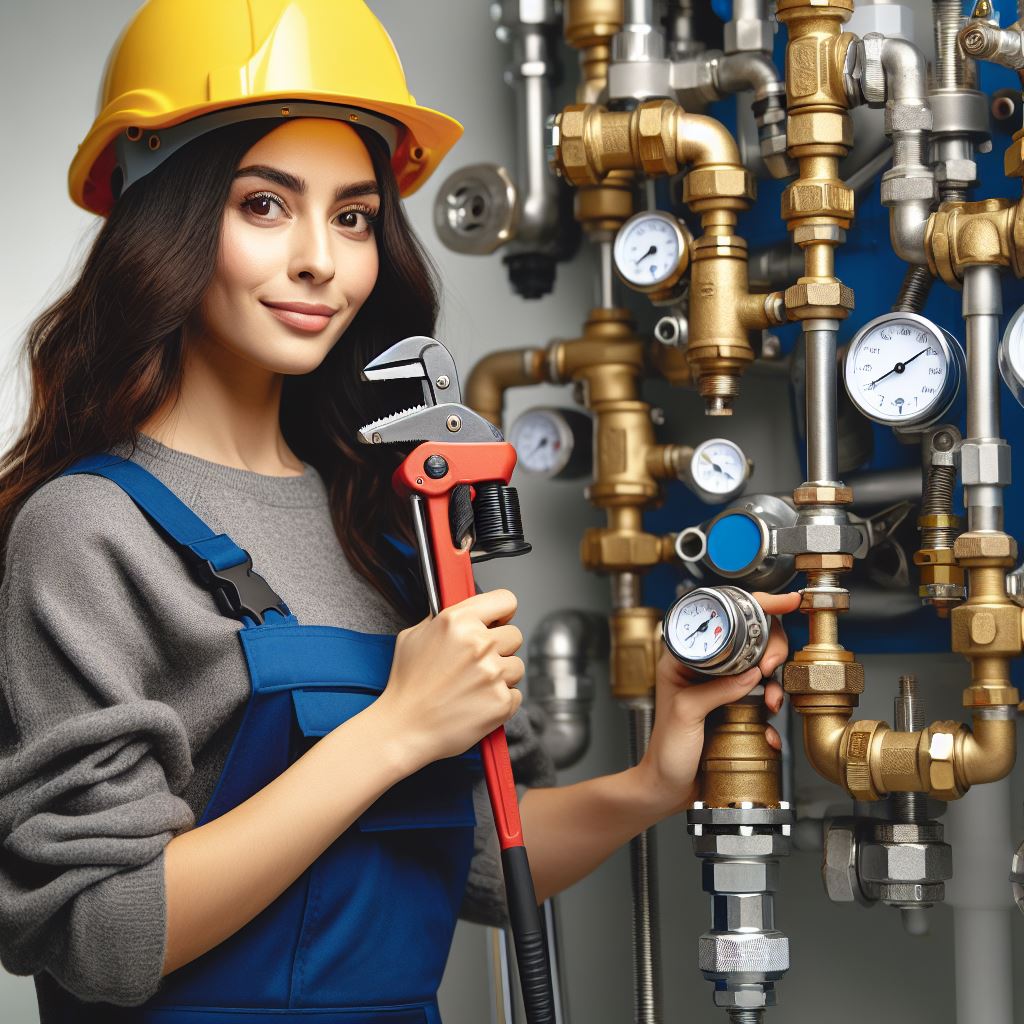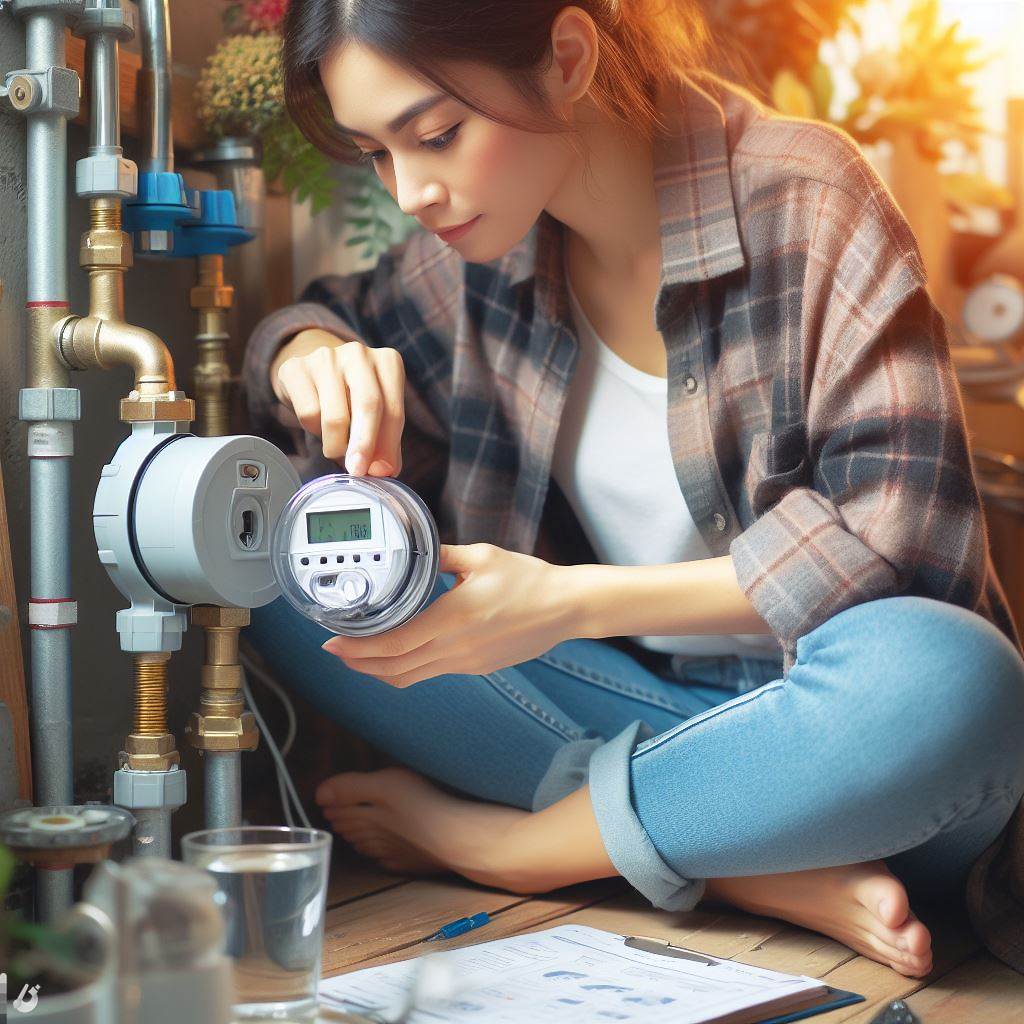Introduction
In this introduction, we delve into the fundamental concept of hydraulics, which involves the study of fluid behavior.
This encompasses the principles governing the transmission of liquids and the interaction between fluids and their containers.
Understanding hydraulics holds significant importance within the realm of plumbing, as it forms the backbone of fluid-based systems.
Plumbing, being an intricate network of pipes and fixtures, relies heavily on the principles of hydraulics for the smooth functioning of water supply and drainage systems.
By comprehending hydraulics, plumbers gain insights into how fluids move through pipes, the impact of pressure variations, and the dynamics of fluid interactions.
Moreover, a profound grasp of hydraulics is essential for troubleshooting and maintaining plumbing systems.
It enables professionals to identify and address issues related to water flow, pressure fluctuations, and potential blockages effectively.
This foundational knowledge contributes to the overall efficiency and longevity of plumbing installations.
Understanding hydraulics is crucial in plumbing, highlighting its pivotal role in designing and maintaining fluid systems in homes and businesses.
What is Hydraulics?
Hydraulics, at its core, is the science and engineering discipline that explores the behavior of fluids and their practical applications.
In plumbing, the principles of hydraulics serve as a cornerstone, providing a systematic understanding of how fluids function within various systems.
Definition of hydraulics
The definition of hydraulics encompasses a comprehensive study of fluid dynamics and the forces exerted by liquids in motion.
It goes beyond mere theoretical knowledge, delving into the practical aspects of harnessing these fluid properties for applications in different industries, including plumbing.
How hydraulics work
Understanding how hydraulics work is essential for those involved in plumbing, as it enables the efficient transmission of power through fluid mediums.
In this context, hydraulic systems capitalize on the incompressibility of liquids to transfer force and energy seamlessly.
This efficiency is particularly crucial in plumbing, where the smooth and reliable movement of fluids is paramount for the proper functioning of water supply, drainage, and other fluid-based systems.
Basic principles of hydraulics in plumbing
The basic principles of hydraulics in plumbing revolve around key concepts such as fluid pressure, flow dynamics, and the interconnected nature of hydraulic components within plumbing systems.
Fluid pressure, for instance, dictates the force exerted by the fluid on the boundaries of its container, influencing the movement and direction of the liquid in pipes and channels.
Furthermore, an understanding of flow dynamics in hydraulics is imperative for designing plumbing systems that optimize fluid movement while minimizing resistance.
This knowledge ensures that water or other liquids can be efficiently transported from one point to another, catering to the demands of residential, commercial, or industrial settings.
In fact, the study and application of hydraulics in plumbing extend beyond a mere definition.
It involves a nuanced comprehension of fluid behavior and the adept utilization of hydraulic principles to create robust and efficient plumbing systems that meet the diverse needs of both residential and commercial contexts.
Components of a Hydraulic System in Plumbing
Hydraulics plays a crucial role in the plumbing industry as it allows for the efficient movement of water and other fluids through a system.
In order to grasp the concept of hydraulics in plumbing, it is important to understand the components that make up a hydraulic system.
These components include pipes and tubes, valves, pumps, and pressure regulators.
Pipes and tubes
Pipes and tubes are the main arteries of a hydraulic system in plumbing. They provide a pathway for the fluid to flow through, ensuring that it reaches its intended destination.
Pipes are typically made of materials such as copper, PVC, or PEX, while tubes are often made of plastic or metal.
Valves
Valves are devices that control the flow of fluid within a hydraulic system. They can be used to start, stop, or regulate the flow of water or other fluids.
There are various types of valves used in plumbing, such as ball valves, gate valves, and check valves. Each type serves a specific purpose and is chosen based on the requirements of the system.
Pumps
Pumps are another essential component of a hydraulic system in plumbing. They are responsible for generating the necessary pressure to move the fluid through the pipes and tubes.
Pumps come in different types, including centrifugal pumps, positive displacement pumps, and submersible pumps. The type of pump used depends on the specific needs of the plumbing system.
Pressure regulators
Pressure regulators are devices that help maintain a consistent and safe pressure level within a hydraulic system.
They prevent pressure from exceeding certain limits, which can lead to damage or leaks.
Pressure regulators ensure that the water flow is controlled and balanced throughout the system, providing optimal performance and efficiency.
In addition to these components, there are other auxiliary parts that contribute to the functionality of a hydraulic system in plumbing.
These include fittings, connectors, filters, and control devices.
Fittings and connectors are used to join pipes and tubes together, while filters help remove impurities from the water.
Control devices, such as pressure sensors and flow meters, provide feedback and enable the monitoring of the system.
The proper design and installation of these components are crucial for the efficient operation of a hydraulic system in plumbing.
Factors such as pipe diameter, pressure requirements, and flow rate must be taken into consideration to ensure optimal performance.
Additionally, regular maintenance and inspections are necessary to identify any potential issues and prevent costly repairs.
Understanding the components of a hydraulic system in plumbing is essential for both professionals in the industry and homeowners.
It allows for a better understanding of how water moves through a plumbing system and provides insight into troubleshooting and solving common plumbing problems.
By having a grasp of hydraulics, individuals can make informed decisions when it comes to plumbing repairs, upgrades, or installations.
In essence, the components of a hydraulic system in plumbing are pipes and tubes, valves, pumps, and pressure regulators.
These components work together to ensure the efficient movement of water and other fluids through a plumbing system.
Understanding these components is vital for maintaining the functionality and performance of a hydraulic system in plumbing.
Read: Green Plumbing: Australia’s Eco Solutions
Common Types of Hydraulic Systems in Plumbing
Hydraulic systems play a crucial role in plumbing, as they are responsible for supplying water to different parts of a building.
There are various types of hydraulic systems commonly used in plumbing, including gravity-fed systems, pressure-assisted systems, and combination systems.
Gravity-fed systems
Gravity-fed systems rely on the force of gravity to move water from a higher point to a lower point.
These systems are typically found in buildings with a water source at an elevated level, such as a rooftop water tank or a hillside reservoir.
Gravity-fed systems are simple, cost-effective, and do not require any additional equipment to boost water pressure.
However, they may not be suitable for buildings with multiple floors or those requiring high water pressure.
Pressure-assisted systems
Pressure-assisted systems, on the other hand, utilize external forces to increase water pressure.
These systems incorporate pressure tanks or pumps to generate enough pressure for water distribution.
Pressure tanks store water under pressure, allowing consistent flow and adequate pressure even in buildings with multiple floors.
Pumps, on the other hand, actively push water through the plumbing system, ensuring a steady supply and adequate pressure.
Pressure-assisted systems are ideal for buildings that require high water pressure, such as commercial establishments or multi-story residential buildings.
Combination systems
Combination systems combine elements of both gravity-fed and pressure-assisted systems.
These systems use gravity for initial water flow and pressure tanks or pumps to maintain pressure.
Combination systems provide the benefits of both types of systems, ensuring a reliable water supply and suitable pressure in a variety of building conditions.
This type of system is often used in larger buildings or complexes where a mix of gravity and pressure is necessary to meet the demand.
When selecting a hydraulic system for plumbing, it is essential to consider factors such as building size, water source, and desired water pressure.
Gravity-fed systems are suitable for smaller buildings with a single water source at an elevated level.
Pressure-assisted systems are ideal for buildings with multiple floors or those requiring high water pressure.
Combination systems offer flexibility and reliability, making them suitable for various building types.
Regular maintenance is crucial for hydraulic systems to ensure optimal performance and longevity.
It is necessary to inspect and clean water storage tanks, pipes, valves, and pumps regularly.
Any leaks or blockages should be promptly addressed to avoid potential damage and water wastage.
Additionally, it is essential to monitor water pressure and adjust settings as necessary to maintain an efficient and reliable hydraulic system.
In general, understanding the common types of hydraulic systems used in plumbing is essential for designing and maintaining an efficient water distribution system.
Gravity-fed systems, pressure-assisted systems, and combination systems each have their advantages and are suitable for different building requirements.
Regular maintenance and monitoring are crucial to ensure the optimal performance of hydraulic systems in plumbing.
By selecting the most appropriate system and properly maintaining it, buildings can enjoy a reliable water supply and adequate pressure for their plumbing needs.
Your Personalized Career Strategy
Unlock your potential with tailored career consulting. Get clear, actionable steps designed for your success. Start now!
Get StartedRead: Plumbing Maintenance Tips for Aussie Homes
Applications of Hydraulics in Plumbing
Hydraulics plays a pivotal role in various applications within the realm of plumbing, influencing the design and functionality of diverse systems. Here are some key applications:
Water Supply Systems
Hydraulics is integral to the design and operation of water supply systems. It ensures the efficient transport of water from its source to consumers.
Hydraulic principles govern the pressure, flow, and distribution of water, ensuring a reliable supply for domestic, commercial, and industrial purposes.
Heating Systems
In plumbing, hydraulics is instrumental in heating systems, such as radiators and underfloor heating. It facilitates the circulation of heated water through pipes, ensuring an even distribution of warmth.
Understanding hydraulics is crucial for optimizing the performance and energy efficiency of heating systems.
Irrigation Systems
Agricultural and landscaping irrigation systems leverage hydraulics to distribute water effectively.
By employing hydraulic principles, these systems can precisely control the flow and pressure of water, ensuring that crops, lawns, and gardens receive adequate and targeted irrigation.
Drainage Systems
Hydraulics plays a critical role in drainage systems, aiding the swift and efficient removal of wastewater and stormwater.
Properly designed hydraulic systems prevent waterlogging, mitigate the risk of flooding, and ensure the effective transport of liquid waste from various sources to treatment facilities.
The applications of hydraulics in plumbing extend beyond these examples, influencing a wide array of systems that rely on the principles of fluid dynamics.
Hydraulics, a backbone in plumbing, ensures steady water supply, optimizes heating, aids agriculture irrigation, and manages wastewater disposal for system functionality and sustainability.
Read: Australian Plumbing: Commercial vs. Residential

Factors Affecting Hydraulic Efficiency in Plumbing
Hydraulic efficiency in plumbing is crucial for the proper functioning and performance of a plumbing system.
Several factors can affect the hydraulic efficiency, and understanding them is essential for maintaining a reliable plumbing system.
In this section, we will discuss the key factors that influence hydraulic efficiency in plumbing.
Pipe Diameter and Material
- The diameter and material of the pipes used in plumbing systems play a significant role in hydraulic efficiency.
- Larger diameter pipes allow for better flow and reduced pressure losses, improving hydraulic efficiency.
- Choosing the right pipe material, such as copper or PEX, can also enhance hydraulic efficiency.
Water Pressure and Flow Rate
- The water pressure and flow rate in a plumbing system affect hydraulic efficiency.
- High water pressure can put stress on the pipes, leading to leaks, while low pressure can result in reduced flow.
- Optimizing water pressure and flow rate through proper adjustment can improve hydraulic efficiency.
Proper Valve Selection and Installation:
- Installing the right valves in a plumbing system is crucial for maintaining hydraulic efficiency.
- Valves control the flow and pressure of water, and selecting suitable ones for specific applications is important.
- Proper valve installation, including correct positioning and sealing, ensures optimal hydraulic efficiency.
Regular Maintenance and Repair
- Regular maintenance and repair of plumbing systems are essential for preserving hydraulic efficiency.
- Any leaks, blockages, or malfunctions should be promptly addressed to prevent loss of efficiency.
- Scheduled inspections, cleaning, and repairs can help maintain optimal hydraulic performance.
To attain hydraulic efficiency in plumbing, consider factors like pipe diameter, material, water pressure, flow rate, valve selection, installation, and regular maintenance.
Understanding and addressing these factors are necessary for ensuring a reliable and efficient plumbing system.
Read: Plumbing Safety Tips for Australian Pros
Learn More: The Role of AI in Mech Engineering Today
Gain More Insights: Women in Carpentry: Changing the Scene
Benefits of Understanding Hydraulics in Plumbing
Hydraulics play a crucial role in plumbing systems, allowing for the efficient distribution of water within a building.
By understanding the principles of hydraulics, you can maximize the benefits of your plumbing system. Here are some advantages of understanding hydraulics in plumbing:
Stand Out with a Resume That Gets Results
Your career is worth more than a generic template. Let us craft a resume and cover letter that showcase your unique strengths and help you secure that dream job.
Get HiredEfficient water distribution
When you grasp the hydraulics of your plumbing system, you can ensure that water is distributed evenly and efficiently throughout your establishment. This enables you to optimize water usage and minimize wastage.
Cost savings in water usage
By understanding how hydraulics work, you can identify areas where water may be unnecessarily wasted.
This knowledge allows you to implement water-saving measures such as installing low-flow fixtures and fixing leaks promptly.
As a result, you can significantly reduce your water bills and conserve this precious resource.
Increased system reliability and performance
A solid understanding of hydraulics enables you to design and maintain a plumbing system that performs at its best.
By factoring in the principles of hydraulics during installation, you can minimize issues like water hammer and ensure proper flow throughout the system.
This results in a reliable and efficient plumbing system that consistently meets your needs.
Prevention of leaks and water damage
The study of hydraulics equips you with the knowledge to detect potential causes of leaks and water damage within your plumbing system.
By being aware of pressure imbalances, improper pipe sizing, and potential blockages, you can take proactive measures to prevent these issues.
This saves you from costly repairs and the hassle of dealing with water damage.
In addition to these benefits, understanding hydraulics in plumbing also allows you to effectively troubleshoot and diagnose problems within your plumbing system.
With this knowledge, you can confidently tackle issues like low water pressure, drainage problems, or inefficient water flow.
To gain a thorough understanding of hydraulics in plumbing, consider investing time in learning about pipe sizing, pressure calculations, and water distribution systems.
This knowledge will empower you to make informed decisions regarding your plumbing system, ensuring its optimal performance and longevity.
It is worth noting that while understanding hydraulics is beneficial, it is always wise to consult professionals for complex plumbing projects or repairs.
They possess the expertise and experience to tackle intricate hydraulics-related challenges and ensure the safety and functionality of your plumbing system.
Ultimately, understanding hydraulics in plumbing comes with numerous benefits.
From efficient water distribution and cost savings to increased system reliability and prevention of leaks, this knowledge empowers you to optimize your plumbing system’s performance.
Invest time in learning about hydraulics to reap these advantages and make well-informed decisions regarding your plumbing system.
Gain More Insights: Sustainable Landscaping in Australian Cities
Learn More: Starting a Landscaping Business Down Under
Uncover the Details: Australian Carpentry Regulations Update
Conclusion
Understanding hydraulics in plumbing is crucial for professionals and DIYers, forming the basis for successful projects.
In the professional realm, precise hydraulics knowledge empowers plumbers to make informed decisions.
This includes selecting pipe diameter and material, considering water pressure and flow rate, and ensuring meticulous valve installation.
The practical link between hydraulics and plumbing yields tangible benefits like enhanced system efficiency, resource conservation, and extended infrastructure lifespan.
For DIYers, recognizing hydraulics’ significance is a transformative step toward rewarding projects.
An active call encourages further exploration and study, inviting enthusiasts to delve into fluid dynamics intricacies.
This pursuit promises a wealth of knowledge, providing insights to optimize project outcomes.
Delving into hydraulics in plumbing opens doors to information and strategies.
It involves unraveling fluid behavior complexities, understanding pipe nuances, and mastering water pressure dynamics.
This holistic approach equips DIYers with necessary skills and empowers them to confidently navigate plumbing project challenges.
In conclusion, understanding hydraulics is a cornerstone for both professionals and DIYers.
The call to explore and study hydraulics is a rallying cry to embrace the vast potential in fluid dynamics and plumbing.
This journey promises optimal project results and a profound appreciation for the intricate dance between water and pipes, underpinning plumbing systems’ efficiency and resilience.




